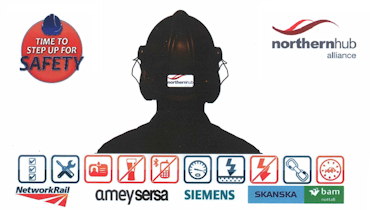Graham writes:
I attended an excellent Step-up for Safety session earlier this week.
It was one of four sessions this week to support health, safety and wellbeing of the workforce run by the Northern Hub Alliance.
The hub has had 2.5 million working hours since work began in 2014, and is due to finish at the end of this year. It’s important that we all push through and stay focused right to the end of the project: we can’t take our eyes off the ball and get lax about safety.
The session was about safety, but it was unusual in that it included mental health, and how the way you think and make assumptions has an impact on safety.
As I arrived at the Marriot Hotel in Manchester there was a young woman asleep on a wall in the sun. She looked as if she was homeless so I asked her if she was OK. She just didn’t respond – as if she was in a deep sleep.
Triple jumper Nathan Fox
After the introductory session, Nathan Fox, the triple jumper, spoke about mental resilience. He described his battles with mental health and how you need to learn to cope with stress.
He told us how he’d been celebrated as the UK’s one hope for a gold medal at an international competition. Before the games he’d gone up to the American athlete and offered to shake his hand, and received a torrent of abuse. It had completely thrown him and he hadn’t even qualified – his mind hadn’t been in the right place as a result of the encounter.
It’s not about work and sleep – you have to have a life too. He struggled with his performance until finally he was diagnosed with chronic fatigue syndrome. Now has more of a balance. He talked about how people have different metabolisms and you need to listen to your body. For example, he won’t drink coffee in the afternoon (it stays in your system for six hours) but his trainer can drink a cup at bedtime. He won’t watch heavy dramatic TV at night, and keeps away from phones and lights because they affect his sleep. By relaxing and changing his attitude he improved his sporting performance enormously.
He is now part of a group called 7 Futures which promotes wellbeing programmes.

Polar bears and yoga
He showed us a video called ‘Why polar bears don’t need to do yoga’. The bear was shaking after it was tracked by a helicopter and shot to be sedated. Then it breathed very deeply three or four times and amazingly quickly became calm. Nathan talked about applying similar techniques to your everyday life – there’s a lot of truth in that old saying about taking 10 deep breaths to calm you down. Your blood thickens when you’re stressed. It’s historically so if a predator injured you your bloodflow would be slow, and you wouldn’t lose too much blood – you’d have a chance to survive. But now it can be a reason for a heart attack from stress. (I practiced when I got home – really helps you get to sleep.)
One of his key points was that we shouldn’t confuse mental strength with resilience – they’re not the same. Managing stress doesn’t get easier, you just get stronger, even ‘battle-hardened’, and better able to cope.
I was really impressed with him – he spoke for just 40 minutes but it was superb and he really held everyone’s attention.
Saving passengers on the Titanic
 After a coffee break, drama group Dramanon did a ‘shipwreck’ exercise with us – who would you save from the Titanic’s passenger list? We talked about the assumptions we’d made, based on the descriptions of people. They can be very misleading – you can make the wrong decisions when you don’t have all the information.
After a coffee break, drama group Dramanon did a ‘shipwreck’ exercise with us – who would you save from the Titanic’s passenger list? We talked about the assumptions we’d made, based on the descriptions of people. They can be very misleading – you can make the wrong decisions when you don’t have all the information.
On the Titanic, because it was assumed the ship was unsinkable, there weren’t enough lifeboats; what assumptions do we make about safety? I really enjoyed that session very much.
A culture of safety
The actors also talked about cultures – the library culture, the pub culture, the work culture. What’s the culture when you walk into the library? We fit our behaviours to the culture, and we need to be sure that our work culture is firmly around safety, and make it clear that unsafe behaviour is not acceptable.
They did a roleplay, acting a scenario about a designer on a job where a man was seriously burned. She blamed herself for the mistake. They talked about her (she wasn’t there) and how she had rung in sick. When the woman on the wall outside came in you could see the whole room react. The message was looking at how people had reacted to her mental strain; by not helping her, although it wasn’t actually her fault, she lost everything. We talked about how it had affected her. You need to stop and think – you can lose everything if you don’t take care of your mental health. We also discussed how no-one challenged the mistakes that led to the accident. Then the actors did the scenario again: and doing it the right way, where people challenged the unsafe mistakes, all went well – no-one was hurt.
It’s a fine line between stress and risk. Stress can give you energy and be positive, but if there’s too much or you react in the wrong way, it can make you ill. And if stress leads to taking risks, that can lead to accidents with very serious consequences.
Continuous improvement

The UK is definitely leading the rest of the world in safety – we are doing well, and we want to continue to do better.
This sort of session, which was excellent, is definitely going to help all who have attended.

